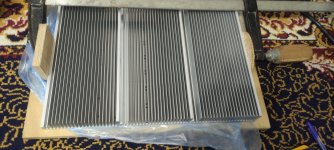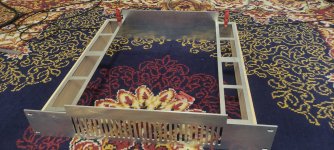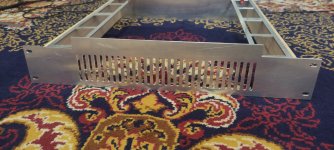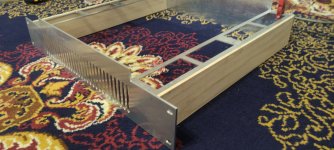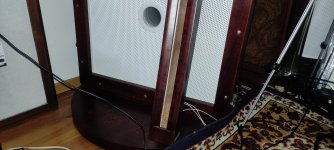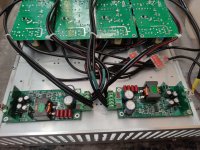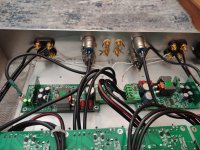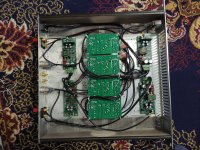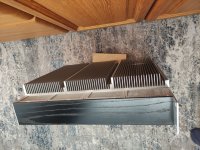On the drum where the video heads are also have audio heads that write in hi-fi format, but the problem is that in this method of recording the video signal is recorded over the audio and noticeably wipe it, but if the video signal is turned off, then only the audio signal remains and it is no longer wiped by the video signal.The recording becomes with a large resource of saving.Using the video heads for audio will be less noisy, will provide higher dynamic range and bandwidth.
Guys, I don't sell these amps, NO TRADING!!!!
I bought the amplifiers from a guy who made a circuit based on the topology of this amplifier, but finalized it. Some of its parameters are even better than the original.
The fact that I milled on the front panel the name purify is my joke and smart people understand it.
I bought the amplifiers from a guy who made a circuit based on the topology of this amplifier, but finalized it. Some of its parameters are even better than the original.
The fact that I milled on the front panel the name purify is my joke and smart people understand it.
Video tape recorders have two ways of recording-longitudinal as on ordinary audio tape recorders, and there is a transverse called high-fi with FM modulation.
Longitudinal recording on the tape is written by a separate audio head, which is in a static position, the quality of such recording in the frequency range of 50-15000Hz on average.
High-file audio recording is made by heads installed on the drum, there are two audio heads, they have nothing to do with video heads, which are also installed on the drum.Recording by such audio heads is made standard 20-20000Hz and dynamic range of 90Db.
So these video heads were disconnected at all, only two (each per channel, left and right) audio heads are functioning.
I'm talking about the video tape recorder shown in the video, it's S-VHS format.
But there is a format Betacam SP, in this format the same heads record audio and video, it will not be possible to disable the video signal when recording.
I wrote above that the video signal is recorded over the audio and partially destroys the audio signal, in the case of disabling the video signal this does NOT happen.
Of course I am only interested in those formats that record ANALOGOUS signal.
Longitudinal recording on the tape is written by a separate audio head, which is in a static position, the quality of such recording in the frequency range of 50-15000Hz on average.
High-file audio recording is made by heads installed on the drum, there are two audio heads, they have nothing to do with video heads, which are also installed on the drum.Recording by such audio heads is made standard 20-20000Hz and dynamic range of 90Db.
So these video heads were disconnected at all, only two (each per channel, left and right) audio heads are functioning.
I'm talking about the video tape recorder shown in the video, it's S-VHS format.
But there is a format Betacam SP, in this format the same heads record audio and video, it will not be possible to disable the video signal when recording.
I wrote above that the video signal is recorded over the audio and partially destroys the audio signal, in the case of disabling the video signal this does NOT happen.
Of course I am only interested in those formats that record ANALOGOUS signal.
What's the point of listening MP3 of the "latest and greatest" on a computer i.e. posting youtube staff.
Look what I've got???
Look what I've got???
So, I decided to make a decent enclosure for my power amp (the one that is NOT purify).
It turned out that my garage homemade CNC machine can easily process aluminum, although I made it for wood.
Since the amplifier is dual, one for high frequencies and the other for low frequencies, and it consists of four modules and four power supplies, I decided to do the appropriate cooling.
I bought three heatsinks and glued them into one, to it all modules-amplifiers and power supplies will be attached, it will also serve as a cover for the amplifier, but the whole case will be ventilated.
It turned out that my garage homemade CNC machine can easily process aluminum, although I made it for wood.
Since the amplifier is dual, one for high frequencies and the other for low frequencies, and it consists of four modules and four power supplies, I decided to do the appropriate cooling.
I bought three heatsinks and glued them into one, to it all modules-amplifiers and power supplies will be attached, it will also serve as a cover for the amplifier, but the whole case will be ventilated.
Attachments

Keep it civil and keep it on topic. There may be more deletions as the last twenty+ posts appear to have nothing to do with the thread topic.
Since here you can not write about the amplifier for my electrostatic speakers, those who wish can go to the Ukrainian forum where my topik has been maintained since 2012.
There you can write not only about the amplifier for electrostatic speakers, but even (God forgive me) post clips of the sound of these electrostatic speakers.
My topic there is called "Электростатические панели".
I will not give a direct link, because it is not allowed here either.
I'll stop here for now.
There you can write not only about the amplifier for electrostatic speakers, but even (God forgive me) post clips of the sound of these electrostatic speakers.
My topic there is called "Электростатические панели".
I will not give a direct link, because it is not allowed here either.
I'll stop here for now.
The amplifier is fully assembled, works perfectly.
That is, four amplification modules, each separately for the right and left treble channels and each for the right and left bass channels, as well as four power supplies.
I connected everything with professional Klotz speaker wires.
The input to the amplifier was made with a balanced connection because I use a professional crossover for high frequencies and an equalizer for low frequencies, and they also have a balanced connection (XLR).
That is, four amplification modules, each separately for the right and left treble channels and each for the right and left bass channels, as well as four power supplies.
I connected everything with professional Klotz speaker wires.
The input to the amplifier was made with a balanced connection because I use a professional crossover for high frequencies and an equalizer for low frequencies, and they also have a balanced connection (XLR).
Attachments
Once again I re-tuned the design of the low-frequency region of my electrostatic speakers.
As a result, the equalizer was not needed; the 400Hz peak was removed empirically.
As a result, the equalizer was not needed; the 400Hz peak was removed empirically.
- Home
- Loudspeakers
- Planars & Exotics
- Full-range, two-way ESL

